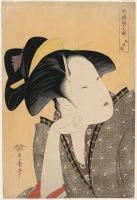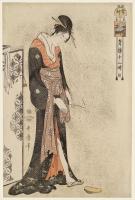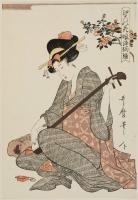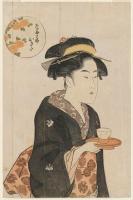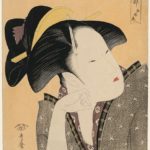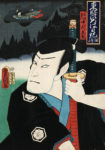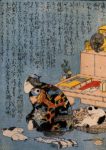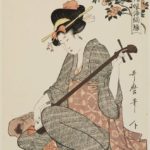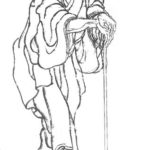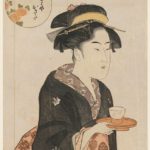Table of Contents
Biography of Kitagawa Utamaro(1753?-1806)
When talking about portraying beautiful women of ukiyo-e prints, we can’t describe it without touching on Kitagawa Utamaro (喜多川歌麿). He developed the new ways to draw Edo women and it made him as a maestro of bijinga(printing of beautiful women portrait).
The time of Kitagawa Toyoaki(北川豊章)
It is unclear when and where he was born exactly but the most experts think his birthplace as Edo(Tokyo). From the beginning, he had the family name Kitagawa but the different kanji “北川”.
He studied the drawing under Toriyama Sekien(鳥山石燕), who produced the famous ukiyo-e artworks of the monsters, in his childhood.
In 1775, he experienced the working of ukiyo-e, “Forty-eight Famous Loves Scenes”, for the first time as Kitagawa Toyoaki. Toyoaki drew first Nishiki-e(color print) of Kabuki actor portrait “Yoshizawa Iroha I as Osato, daughter”.
But he mostly had drawn the pictures for the illustrationa cuts in this period and was affected by Katsukawa School.
Utamaro and Tsutaya Juzaburo
While Japanese name era changed into Tenmei(1781-1789), he also started to use the new name, Utamaro. It was the golden age of Torii Kiyonaga in the field of Bijinga. Kitagawa Utamaro became to follow the drawing way of Kiyonaga.
Then Utamaro belonged exclusively for Tsutaya Juzaburo(蔦屋重三郎). The man around his age was the young publisher and discovered his artistic talent. The publisher launched the project of the mysterious ukiyo-e artist Toshusai Sharaku(?-?) and made the prints of the Japanese great painter Katsushika Hokusai(1760-1849) afterward.
Utamaro began to draw pictures under Juzaburo and he soaked up the various styles of the beautiful women portrait prints. And gradually played an active part in that field.
In addition, they published many kyoka (comic tanka) picture books using many colors. They were realistic artworks with subjects of flowers, fish, birds, and beasts.
The trilogy of “Picture Book: Selected Insects”(『画本虫撰』, Ehon mushi erami), “Gift of shell gathering”( 『潮干のつと』, Shiohi no tsuto) and “All sorts of birds”(『百千鳥』, Momochidori), were drawn from 1788 to 1790, and masterpiece of Utamaro’s kyoka.
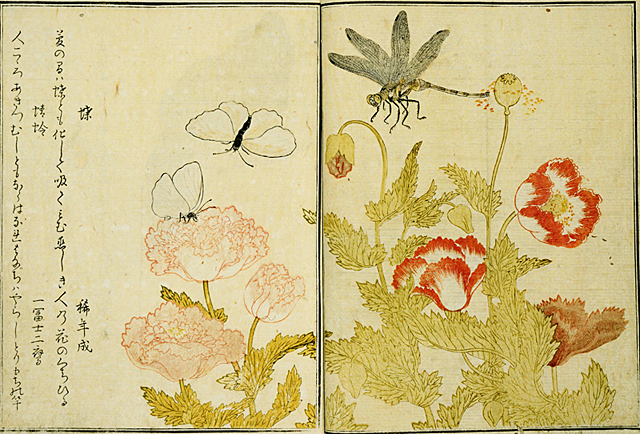
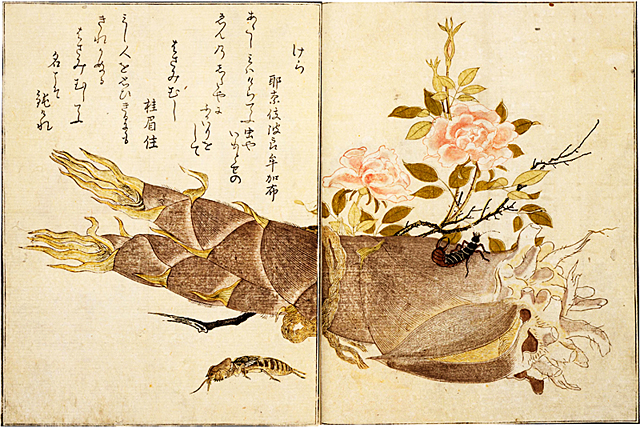
His new style “Ookubi-e” and glory days
After that, the new drawing way of Bijinga immediately pushed Kitagawa Utamaro up to a first-class painter. It was a technique called “Ookubi-e”, every ukiyo-e artists draw a woman’s whole body until then, he imaged the upper half of the body that zoomed in on the model.
It made it possible to express the women’s expressions and fingers finely, and convey the inner side more deeply.
And to draw women’s softness and richness for the portrait, he used various techniques including using mica powder, making the background yellow and coloring the outlines with red. According to one theory that Juzaburo gave the ideas and coloring materials for the ukiyo-e artist.
The masterpieces that he painted in this period, which is the heyday of Utamaro, are the series of “Anthology of love”(歌撰恋之部, Kasen Koi no bu), “Ten Learned Studies of Women “(婦人相学十躰, Fujin sogaku jittei), “Six most beautiful women”(高名美人六家撰, Komei Bijin rokkasen), “Famous Beauties of Edo”(当時全盛美人揃, Toji zensei Bijin zoroi), and especially “Twelve Hours of the Green Houses “(『青楼十二時』, Seiro juu-niji) which made one day of Yoshiwara’s prostitute.
So French author Edmond Goncourt called him”painter of official brothel”. However, he created the prictures of the middle class women as much as the portraits of courtesans.
The Ohisa and Otaka who became models of “Three beauties of the present day” were originally just the town girls. But they became the famous in Edo city by the prints of Utamaro.
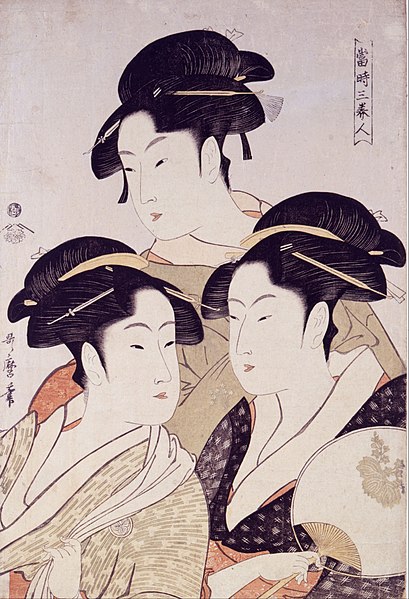
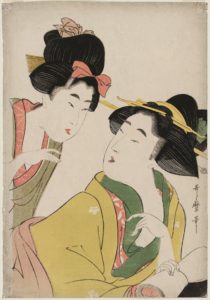
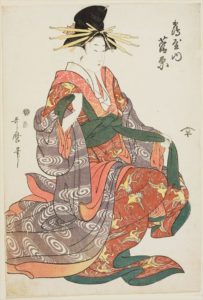
“Ten women’s physiognomy”contains one of the most famous his artworks of prints, Woman Playing a Poppin.
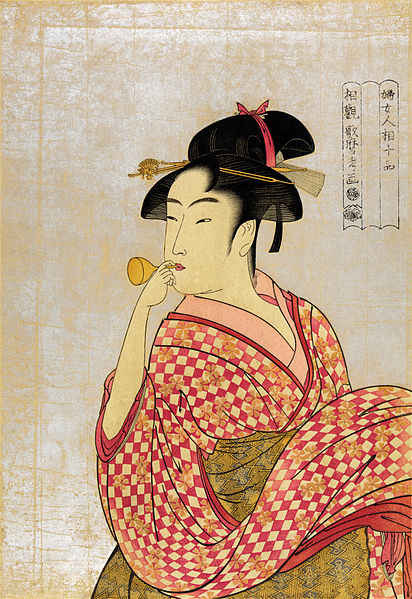
At that time, the member of shogun’s council started the reform of Kansei and prohibited the people’s luxury. The regulation cover ukiyo-e also. However, Utamaro and Shigesaburo have devised a method to effectively express it with few colors, taking advantage of that.
The last years in disappointment
A tragedy happened to him at the peak of his popularity. In 1797, his strong supporter Tsutaya Juzaburo died. With the death of the editor who gave a lot of advice to the ukiyo-e artist, he lost the person to rely on the work.
But, ironically, the reform of Kansei finished four years ago, and the demand for Utamaro’s bijinga had increased remarkably. Because his exclusive publisher didn’t exist already, several editors brought him a request for painting, and the number of his works rose sharply.
His woodblock prints had undergone a major change, as Juzaburo’s assistance ceases to exist as well as having to make many works.
While descending downhill, he finally received a crushing blow in 1804. The shogunate decided that he was guilty because he handled “Picture of Hideyoshi and his Five Wives Viewing the Cherry-blossom at Higashiyama”(太閤五妻洛東遊観之図, Taiko gosai rakuto yukan no zu). As Toyotomi Hideyoshi had turned against Tokugawa Ieyasu.
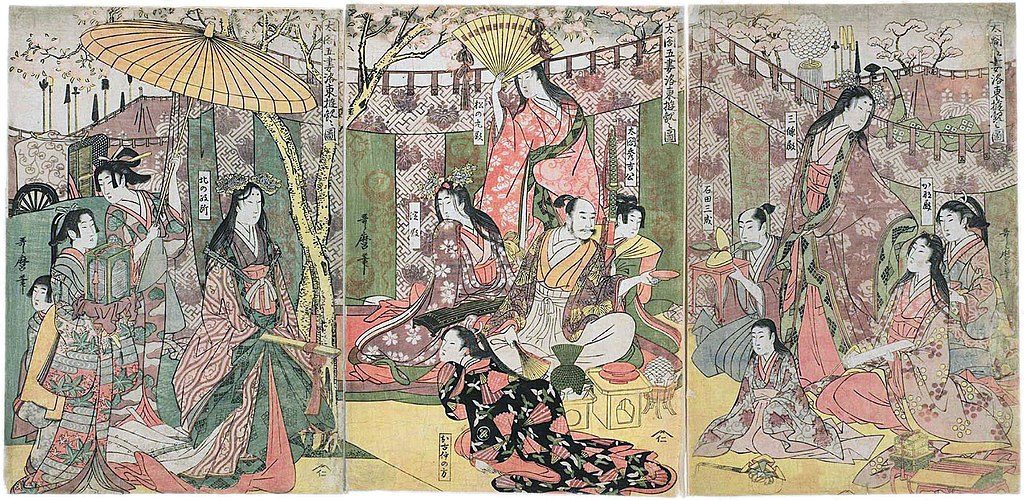
Utamaro entered the prison due to that crime, and after leaving there, he had to live with chains in his wrists for 50 days.
Even after the term of imprisonment ended, his energy didn’ come back and died in 1806 with drawing a few pictures. A painter who took the citizens of Edo captive with a revolutionary beautiful woman portrait is sleeping in the grave of Shenkoji temple in Setagaya Ward, Tokyo.
The gallery of Utamaro’s woodblock prints

